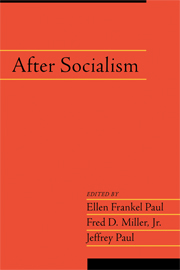Book contents
- Frontmatter
- Contents
- Introduction
- Acknowledgments
- Contributors
- Can There Be an “After Socialism”?
- The Cultural Contradictions of Socialism
- The Idol of History
- Backwards into the Future: Neorepublicanism as a Postsocialist Critique of Market Society
- What's Left of the Welfare State?
- The Roots and Rationale of Social Democracy
- An Interpretation and Defense of the Socialist Principle of Distribution
- Some Feasible Alternatives to Conventional Capitalism
- After Socialism: Mutualism and a Progressive Market Strategy
- Sovereignty, Commerce, and Cosmopolitanism: Lessons from Early America for the Future of the World
- Beyond Fear and Greed?
- Liberalism's Divide, After Socialism and Before
- INDEX
The Idol of History
Published online by Cambridge University Press: 01 June 2010
- Frontmatter
- Contents
- Introduction
- Acknowledgments
- Contributors
- Can There Be an “After Socialism”?
- The Cultural Contradictions of Socialism
- The Idol of History
- Backwards into the Future: Neorepublicanism as a Postsocialist Critique of Market Society
- What's Left of the Welfare State?
- The Roots and Rationale of Social Democracy
- An Interpretation and Defense of the Socialist Principle of Distribution
- Some Feasible Alternatives to Conventional Capitalism
- After Socialism: Mutualism and a Progressive Market Strategy
- Sovereignty, Commerce, and Cosmopolitanism: Lessons from Early America for the Future of the World
- Beyond Fear and Greed?
- Liberalism's Divide, After Socialism and Before
- INDEX
Summary
INTRODUCTION
“The idol of communism, which spread social strife, enmity and unparalleled brutality everywhere, which instilled fear in humanity, has collapsed.” These words, spoken by Russian president Boris Yeltsin before a joint session of the U.S. Congress in 1992, brought a tumultuous response from America's political leaders. The evocation of the theme of idolatry by a former member of the Communist Party was striking, all the more so because it must have called to his listeners' minds the dramatic scenes of the destruction of the statues of Lenin then taking place throughout the Communist world. Nothing of the kind had been seen since the end of the Pagan era, when temples of the old gods were toppled throughout the Roman Empire. The events that historian Edward Gibbon, in his classic The Decline and Fall of the Roman Empire, described as happening in Alexandria in A.D. 389 might just as well have applied to what was happening in Minsk or Tirana: “The huge idol [of Serapis] was overthrown and broken into pieces, [its] limbs ignominiously pulled through the streets.”
Yeltsin's use of “idol” here was of course more figurative than literal. It followed the meaning first given to the term by philosopher Francis Bacon in the seventeenth century, when he identified an idol not with a physical object representing a god, but with false beliefs.
- Type
- Chapter
- Information
- After Socialism , pp. 38 - 58Publisher: Cambridge University PressPrint publication year: 2003



